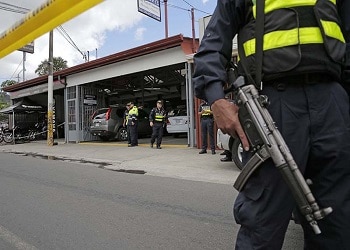A government report on homicides in Costa Rica concludes that organized crime is driving the rising violence in the country, but the study’s shaky methodology leaves it open to questions.
The number of homicides grew by 9.7 percent in Costa Rica between 2010 and 2016, according to an August 2017 report by the Interagency Commission on Citizen Security and Living Conditions (Comisión Técnica Interinstitucional sobre Estadísticas de Convivencia y Seguridad Ciudadana – COMESCO).
After dropping from 527 total murders in 2010 to 407 in 2012, the annual number of homicides increased to 578 homicides in 2016. The murder rate also increased slightly, from 11.5 per 100,000 in 2010 to 11.8 per 100,000 in 2016.
SEE ALSO: InDepth Coverage of Homicides
The report attempts to distinguish murders related to organized crime. The document’s methodology explains that data from the Justice Ministry’s crime analysis and statistics units were used to try to establish motive. The study considers two motives — “score-settling or vengeance,” and hired killings — as related to organized crime. By this standard, the proportion of intentional homicides committed by criminal groups grew from 2.5 percent in 2010 to 46 percent in 2016. In other words, murders related to organized crime exploded by nearly 2,000 percent during the six-year period.
InSight Crime Analysis
The obvious conclusion is that organized crime is driving a spike in violence. And some of the data and anecdotal evidence seems to support this conclusion. The state of Limón, a known drug trafficking hub, has the largest number of murders during the time period studied, followed by the capital, San José. In addition, the victims are the right profile: those between the ages of 15 and 29 suffered the highest increase in homicides, reaching a rate of more than 20 per 100,000 inhabitants. Finally, the report is in line with warnings of increased drug trafficking activities in the country, as well as weakly substantiated claims that drug trafficking is the cause of higher homicides.
SEE ALSO: Coverage of Costa Rica
However, there are reasons to question whether the dynamic has changed as much as the report contends. To begin with, last year’s murder levels are close to those of 2010. And the document’s vague methodology is not convincing. “Score-settling and vengeance” murders are too broad a description to be considered organized crime. The report even admits this category is too vague.
There are at least two ways to remedy this. One is to take a representative sample size of all the murders over a period of time and study the motives in each of those cases as determined by the Attorney General’s Office investigations. The other is to do what InSight Crime did in Guatemala and take a deep dive into the places where authorities believe there is an organized crime presence and test the hypothesis using cases just in those areas.

